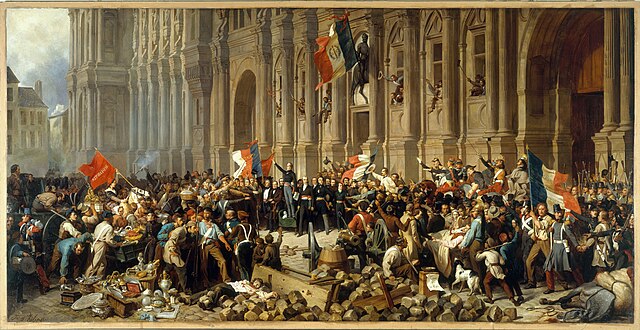Loading AI tools
French painter From Wikipedia, the free encyclopedia
Henri Félix Emmanuel Philippoteaux (French pronunciation: [ɑ̃ʁi feliks emanɥɛl filipɔto]; 3 April 1815 – 8 November 1884) was a French artist and illustrator, known primarily as a battle painter.

He was born in Paris, France, studied art at the studio of Léon Cogniet,[1] and first exhibited his work at the Paris Salon of 1833.[1]

One of his best-known works was a depiction of the Siege of Paris during the Franco-Prussian War,[2][3] painted in the form of a cyclorama, a type of large panoramic painting on the inside of a cylindrical platform designed to provide a viewer standing in the middle of the cylinder with a 360° view of the painting. Viewers surrounded by the panoramic image are meant to feel as if they are standing in the midst of a historic event or famous place.
Philippoteaux also produced a large number of works chronicling the rise and successes of Napoleon, including a portrait of Napoleon in his regimental uniform and a group of paintings of French victories in the Napoleonic Wars. Philippoteaux was awarded the Légion d'honneur in 1846.[1][4]
Philippoteaux's son Paul Philippoteaux was also an artist; both were famous for their production of cycloramas. Father and son collaborated on The Defence of the Fort d'Issy in 1871. They also collaborated on a cyclorama of the Battle of Gettysburg that became a celebrated work in the United States:
"One cyclorama, however, halted the slide in popularity, and almost single-handedly revived the public's interest in the medium for another decade...this singular creation was initially painted in 1882-83 by Henry F. Philippoteaux and Paul Philippoteaux, a father and son team of French artists...within a year, half a million people had stood before it."[5]
Father and son enhanced the artistic effect of their cylindrical painting by adding a third dimension, including elements of diorama placed in front of the painting, and by incorporating sections of walls and battlefield objects that blended into the painted parts of the presentation.[6]
He died in 1884 in Paris and his obituary in the New York Times appeared on November 10, 1884.[1]
Seamless Wikipedia browsing. On steroids.
Every time you click a link to Wikipedia, Wiktionary or Wikiquote in your browser's search results, it will show the modern Wikiwand interface.
Wikiwand extension is a five stars, simple, with minimum permission required to keep your browsing private, safe and transparent.